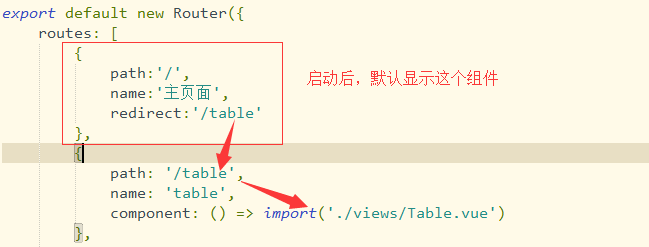1、router-link to 动态赋值
router-link组件的to属性值有两种写法,字符串类型和对象类型
如果要动态传值,比如放到for循环中,传入for的index值,这时就必须使用对象形式,动态传值
<router-link :to="{path:'/old_data_details/params/'+item.id}" > </router-link>

2、路由跳转的三种方式,及返回上一级
1)<router-link to="keyframes">点击验证动画效果 </router-link>
to属性值可以是路由字符串,也可以使对象形式
2)this.$router.push({ path:’/user’})
this.$router.push({ path:'/select', //跳转的路径 query:{ //路由传参时push和query搭配使用 id:this.id , } })
3)this.$router.replace{path:‘/’ } 与push类似
返回上一级使用this.$router.go(-1) ,跳转到指定路由this.$router.push('/home')
3、路由重定向(设置默认路由)

4、vue监听路由变化
1)通过watch函数(注意:必须在跟组件中,才能监听到路由的变化)
// 监听,当路由发生变化的时候执行 watch:{ $route(to,from){ console.log(to.path); } }, 或者 // 监听,当路由发生变化的时候执行 watch: { $route: { handler: function(val, oldVal){ console.log(val); }, // 深度观察监听 deep: true } }, 或者 // 监听,当路由发生变化的时候执行 watch: { '$route':'getPath' }, methods: { getPath(){ console.log(this.$route.path); } }
2)通过 vue-router 的钩子函数 beforeRouteEnter beforeRouteUpdate beforeRouteLeave
<script> export default { name: 'app', // 监听,当路由发生变化的时候执行 beforeRouteEnter (to, from, next) { // 在渲染该组件的对应路由被 confirm 前调用 // 不!能!获取组件实例 `this` // 因为当钩子执行前,组件实例还没被创建 }, beforeRouteUpdate (to, from, next) {
//beforeRouteUpdate守卫并不会在不同路由共用同一组件时触发
//当从/item/22/edit切换到/item/11/edit时,会触发beforeRouteUpdate。
//但如果从/item/22/edit切换到/item/create时,并不会触发beforeRouteUpdate。
// 在当前路由改变,但是该组件被复用时调用,即同一路由下只有参数发生变化的情况下可以用此钩子监听到 // 举例来说,对于一个带有动态参数的路径 /foo/:id,在 /foo/1 和 /foo/2 之间跳转的时候, // 由于会渲染同样的 Foo 组件,因此组件实例会被复用。而这个钩子就会在这个情况下被调用。 // 可以访问组件实例 `this` }, beforeRouteLeave (to, from, next) { // 导航离开该组件的对应路由时调用 // 可以访问组件实例 `this` } </script>
3)如上面提到的 <router-view :key="key"></router-view>
对于一个带有动态参数的路径 /foo/:id,在 /foo/1 和 /foo/2 之间跳转的时候,页面是不是刷新的,即hashChage函数是不会触发的,这时,可以给路由组件router-view添加 :key=""属性来阻止复用
然后动态参数的路由跳转就是可以刷新页面了
Vue 为你提供了一种方式来声明“这两个元素是完全独立的——不要复用它们”。只需添加一个具有唯一值的 key 属性,这样就可以如愿刷新数据了
<router-view :key="key"></router-view> computed: { key() { return this.$route.name !== undefined? this.$route.name +new Date(): this.$route +new Date() } }
5、图片 :src=" " 使用data里面的url时出现404的情况
这么写会出现404错误,图片路径不被webpack解析,直接展示为src='./1.png'
<li v-for="(item,index) in images" :key="index"> <img :src="item.src"></li> //js部分 data(){ return { images:[{src:'./1.png'},{./2.png}] } }
应该这么写,将图片作为模块加载进来require
data(){ return { iconsData : [ { pageName:'guohu', iconUrl:require('../assets/img/guohu.png'), iconName:'过户', toUrl:this.handleUrlStr('guohu') }, { pageName:'xiaohao', iconUrl:require('../assets/img/xiaohao.png'), iconName:'销号及复装', toUrl:this.handleUrlStr('xiaohao') } ] } }
6、vue路由守卫
//创建路由实例 const router = new Router({ routes: [ { path: '/', name: 'home', component: Home, meta:{ isLogin:true // 添加该字段,表示进入这个路由是需要登录的 }//路由元 },{ path:"/login", name:"login", component:Login } ] }) // 路由守卫 router.beforeEach((to,from,next)=>{ if(to.matched.some(res=>res.meta.isLogin)){//判断是否需要登录 if (sessionStorage['username']) { next(); }else{ next({ path:"/login", query:{ redirect:to.fullPath } }); } }else{ next() } }); export default router;
to 表示将要跳转到的组件 (目标组件)
console.log(from); //(源组件)
next();
next 是一个函数
next() 进入下一个组件的钩子函数
next(false) 阻止跳转 中断导航
next("/login") 进入指定的组件的钩子函数
注意:路由守卫处理了逻辑之后,必须调用next()函数,路由才会向下执行
7、区分$router 对象和 $route对象
$router : 是路由操作对象,只写对象 ,用来操作路由的行为
$route : 路由信息对象,只读对象,获取当前路由的信息
参考:https://blog.csdn.net/qq_42928918/article/details/88406257